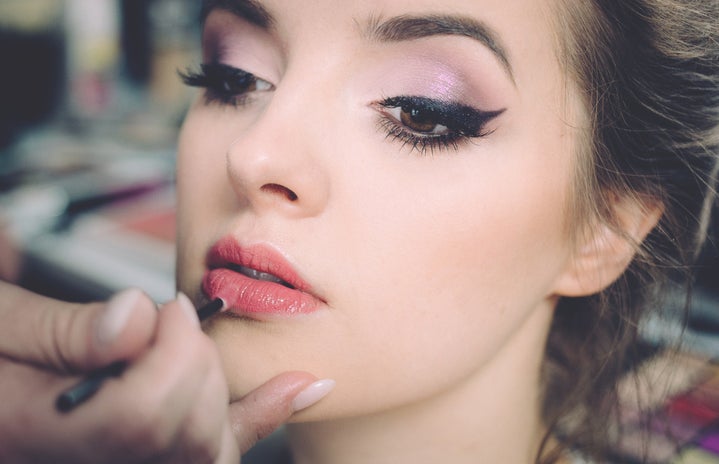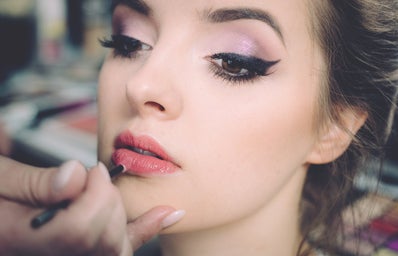For whatever reason, I have always been interested in learning more about my body and the amazing ways it changes throughout the month. At fifteen, I became an ambassador for the period-tracking app Clue, which led me on a path of self-discovery about all things women’s health.
Eventually, my journey led me to learn more about the wonderful (and not-so-wonderful) ways in which your skin changes throughout your menstrual cycle. Which is why, in today’s increasingly body-positive culture, some skin care junkies are now recommending that we sync our skin care routine to our menstrual cycle for that optimal glow.
Just like your weight, your appetite, your mood and even your hair, your skin fluctuates throughout your menstrual cycle. For example, you might have noticed that your skin is oily around the same time each month, or that you tend to break out just before your period. (For me, it’s always a couple days before my period, and it’s always on my chin.) Well, here’s how you can prep for those nasty hormonal changes in advance, and learn to get healthy, glowing skin from Days 1 through 28…
But first, a brief note on the menstrual cycle: Everyone’s cycle varies in length, and this variation is totally normal. However, while I recognize not everyone (myself included!) might follow a 28-day cycle, I’ll be using this model because it is the easiest way to categorize the various “phases” that occur from your period on.
Additionally, if you’re on a method of hormonal birth control that prevents you from ovulating, you might notice a slight difference in the changes you experience throughout the month. Again, all of this is completely normal, I can’t stress it enough!
Days 1 through 7: Your Period
As you might have guessed, you can thank fluctuations in hormones for all the changes, both negative and positive, your body goes through during your menstrual cycle. Your period is no different. During your period, estrogen is low and prostaglandin (aka the hormone you can thank for nasty period cramps!) is high, which might leave your skin feeling oily, blotchy or even super sensitive.
While you’re menstruating, you and your skin might experience the effects of lethargy. To combat dullness and unevenness of skin tone, derms recommend eating and applying more antioxidants, such as green tea or Vitamin C, to your skin.
As for oiliness, acne and clogged pores, you’ll want to plan ahead for your period and switch to a cleanser containing salicylic acid for the week leading up to your period. If you’re someone who has irregular or unpredictable periods, this might get a bit tricky — so your best bet is to switch cleansers as soon as you notice your usual symptoms of PMS, such as bloating, moodiness or weight gain. (Keep reading if you’re curious about this, because I’ll talk more about PMS later!)
Days 8 through 13: The Follicular Phase
In a traditional 28-day cycle, Days 8 through 13 are known as the follicular phase because the follicles in your ovaries are preparing to release an egg. During this time, your estrogen levels will gradually increase, which, hooray, is great news for your skin!
Your skin peaks just before ovulation, when your estrogen levels are at their highest. As your body pumps up its estrogen production, your skin starts to produce new cells and structural proteins called collagen, which give your skin that supple, healthy appearance we all crave.
To amp up the effects of estrogen on your skin, skincare experts recommend using an exfoliator to scrub away dead cells as your body produces new ones. It’s also a great idea to use a brightening or anti-aging mask, especially if you’re in your twenties, to maximize cell turnover and get that follicular glow!
Day 14: Ovulation
Ovulation occurs approximately halfway through the menstrual cycle. So for someone with a 28-day cycle, this occurs on Day 14. As you might remember from middle school health class, ovulation refers to the moment when your ovaries release an egg into your uterus, which will then die (leading to your monthly period) if it is not fertilized within 24 hours.
At this point in your cycle, estrogen remains high, but that heightened estrogen also triggers the production of a new hormone called Luteinizing Hormone (LH). Unfortunately, LH triggers the production of oil in your pores, so this is the point in your cycle where you might see your skin take a turn for the worse and more blemishes start to crop up.
Thankfully, there are many ways to prepare for battle against your greasy, clogged pores and unsightly acne. Firstly, keep makeup and moisturizer light by looking for the word “non-comedogenic,” which indicates the product does not contain excess oil. You might also want to try a purifying mask to purge your pores; personally, I’m a fan of clay and charcoal as detoxifying mask ingredients.
Additionally, it’s important to soothe your skin from the inside out throughout your cycle — but especially during ovulation, as oil production begins to increase. By that, I am of course referring to the importance of diet — because as much as your hormonal self might be craving that greasy slice of pizza and sugary Diet Coke, what your body and skin really need is fruits, veggies and lots and lots of water to combat the negative effects of LH.
Days 15 through 28: PMS
Last but not least, we’re left with one of the most unpleasant and often unpredictable phases of the menstrual cycle: PMS, aka pre-menstrual syndrome. As long as your egg isn’t fertilized on (or before) Day 14, your estrogen levels will take a sharp decline as you approach the end of your cycle and the beginning of your period.
Everyone’s skin and hormones are different, so you might begin to notice a whole host of changes during your PMS phase. For example, you might start to break out, notice hyperpigmentation or uneven skintone or even see skin become puffier with water retention and bloating.
In general, it’s a great idea to drink lots of water during this time to flush out toxins (because let’s face it, when you’re PMSing, you just can’t say no to that pint of ice cream) and decrease the discomfort of bloating. Derms also recommend switching up your skincare routine to contain salicylic acid and a topical retinoid to combat period acne.
Last but not least, if you’re really fed up with the hormonal acne and annoying PMS symptoms, you might consider going on The Pill. One time in high school, my friend’s Catholic mother gasped at me for suggesting my friend try birth control to combat her painful, widespread cystic acne, but it’s true! Combination pills containing both estrogen and progesterone reduce the levels of hormones called androgens, which trigger your skin to produce excess oil when left unchecked. Only three pills (so far, at least) have been approved for treating acne, but they’re still a highly effective option you might consider if you’re tired of fighting your skin throughout your cycle.
Some people find their menstrual cycle confusing; some see it as a wonderful miracle that their bodies are capable of. Either way, getting to know your body and cycle will help you hack your skincare routine, so you can still glow up no matter what time of month it is.
Want to keep up with HCBU? Make sure to like us on Facebook, follow us on Instagram, check out our Pinterest board, and read our latest Tweets!



